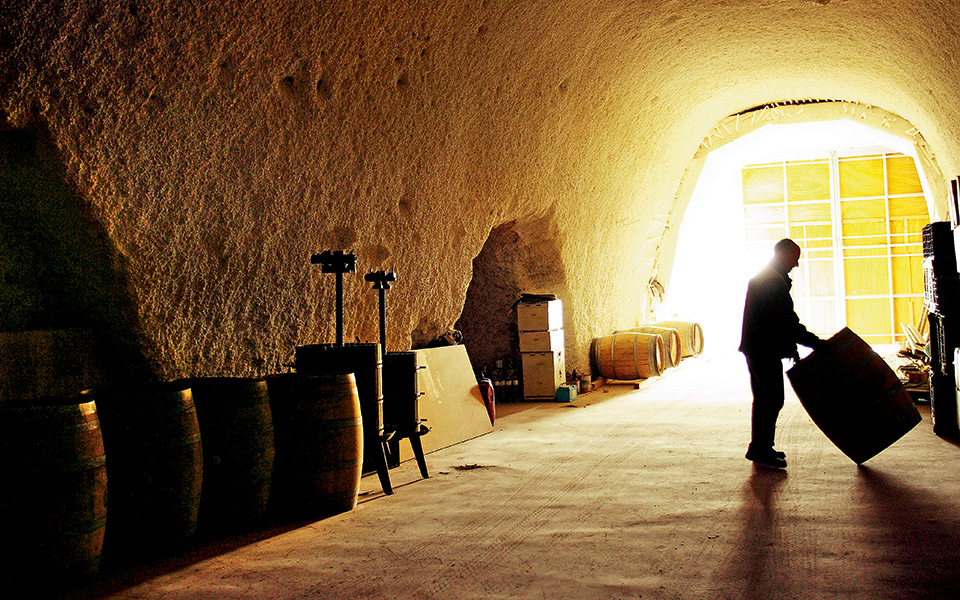VASSALTIS VINEYARDS
THE NEWCOMER
Opened in April 2016, the Vassaltis Vineyards is the newest arrival on the island’s wine scene and a true gem, designed by Evi Polychroniadou and the award-winning MOB architects firm who worked on the interior. The winery is built on three levels, the lowest of which is where the wine is matured in barrels before being bottled (wine store). The nerve center is on the middle floor, where vinification and bottling takes place. Adjacent is the laboratory, while on the ground floor there is a shop and an amazing tasting area, which is a delight for visitors.
Although not a native of Santorini himself, the young owner Yannis Valambous left a career in banking and developed a 4-hectare vineyard that had been in his family for more than two decades. He joined forces with two young but experienced oenologists, Ilias Roussakis and Yiannis Papaeconomou, and today they are hoping to evolve traditions and appeal to an expanding wine-loving audience.
The first bottles from the 2015 vintage received plaudits for their quality and superiority of flavor and now we await, with much anticipation, the 2016 vintage, which will be bottled on Vassalitis’ own premises.
VENETSANOS
INDUSTRIAL PIONEER
Its opening in 1949 as Santorini’s first industrial winery represented a major milestone in the history of winemaking on the island and in the life of its founder, oenologist Giorgos Venetsanos. At a time when Santorini still did not have a public electricity supply, the winery used a generator and pump – and gravity – to channel its wine from the winery to Athinios port below, where ships took it to market. Today, the refurbished winery is run by Nikos Zorzos, a nephew of the founder and the island’s mayor, and his brother Vangelis. The winery produces a 100 percent Assyrtiko, a Nychteri, a rosé from three varieties (Anagallis) and a red Mandilaria, as well as the incredibly sweet Liastos, all of which are produced in limited amounts.
The 2015 vintage wines, as well as some older vintages, are available to purchase from the winery’s fashionable boutique.
INFO
Vassaltis Vineyards • Vourvoulos
• Tel. (+30) 22860.222.11
WHY GO: For the modern architecture that is so perfectly incorporated into the natural environment • To taste their first bottling.
Venetsanos • Megalochori
• Tel. (+30) 22860.211.00
WHY GO: Amazing location with a beautiful view of the island.
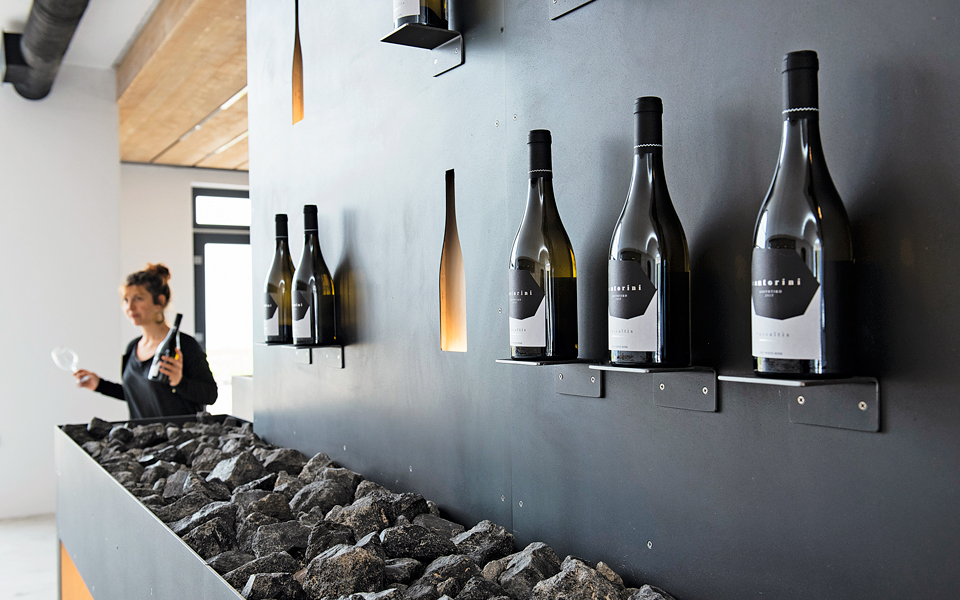
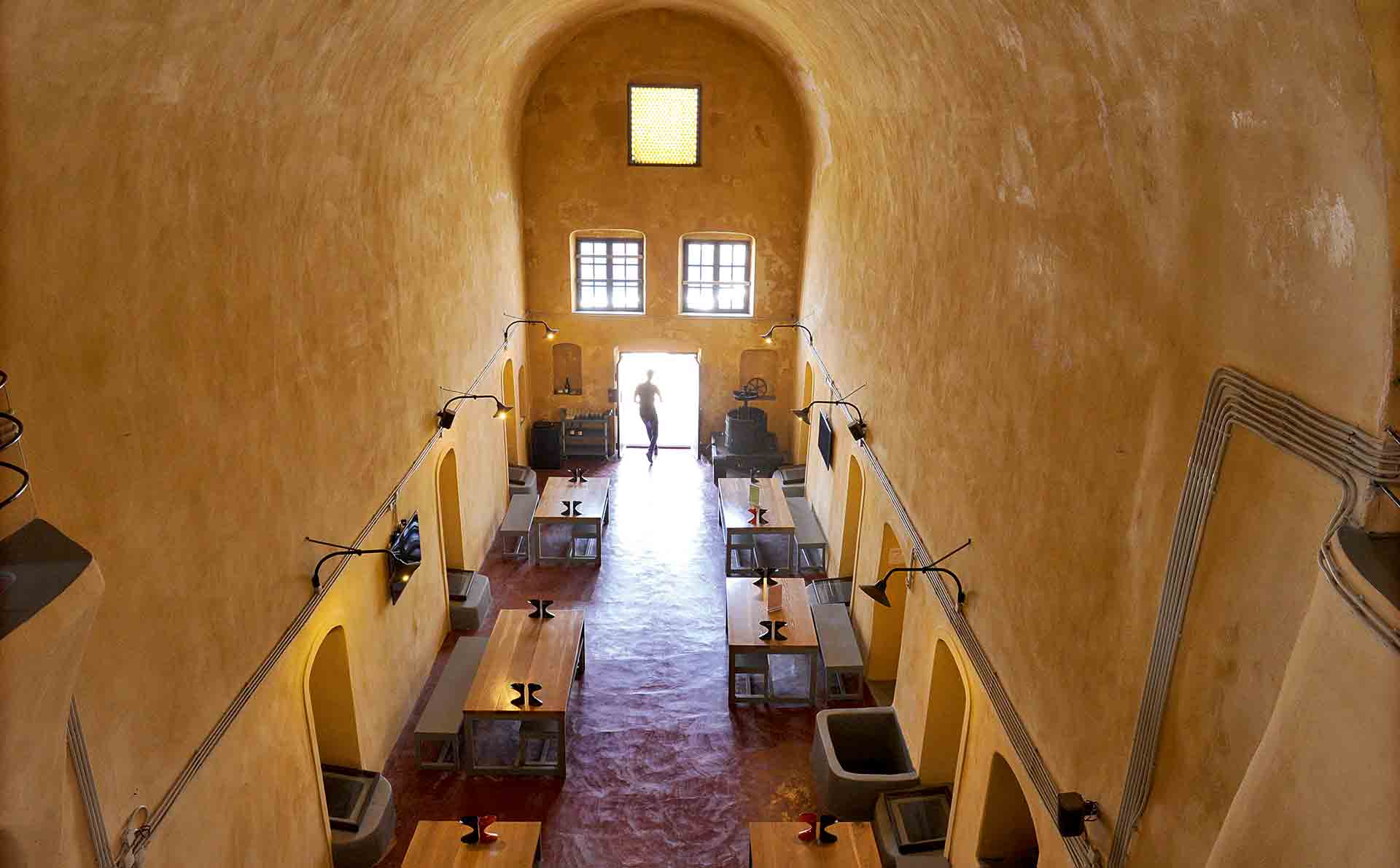
© Vangelis Zavos
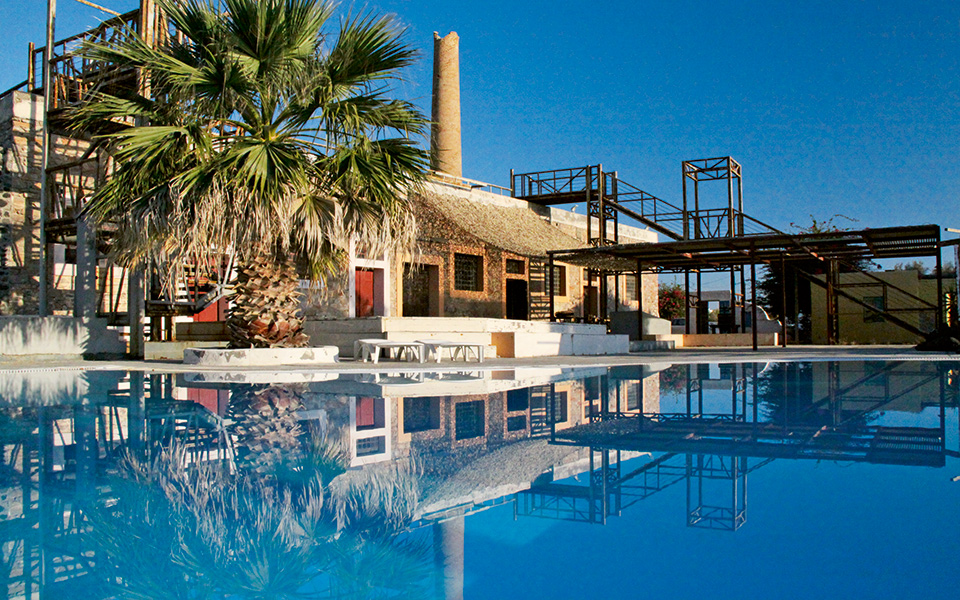
© Vangelis Zavos
INFO
Gaia Wines • Exo Gonia
• Tel. (+30) 22860.341.86
WHY GO: Enjoy a complete tasting experience right in front of the Black Beach.
GAIA WINES
DEDICATED TO ASSYRTIKO
Behold one of the island’s greatest examples of industrial architecture – an old stone tomato factory converted into a modern winery. It’s been almost 25 years since Yiannis Paraskevopoulos, who holds a PhD in oenology from the University of Bordeaux II, and agronomist Leon Karatsalos gave the space a second life by creating Gaia Wines.
Its flagship Thalassitis label is one of the island’s most symbolic wines, so renowned that it has become synonymous in the minds of many with Assyrtiko. The grapes used to make it come from low-yield vineyards in Episkopi, Akrotiri and Pyrgos. Gaia makes four wines as well as an excellent vinegar from Assyrtiko, which is aged in French oak barrels for at least five years. The winery’s tastings include four whites and four reds, as well as the vinegar, which is served at the end. Be sure to ask for Thalassitis, which is best served decanted so as to reveal its true character. Even though it is a white wine, it has similar behavior to a red.
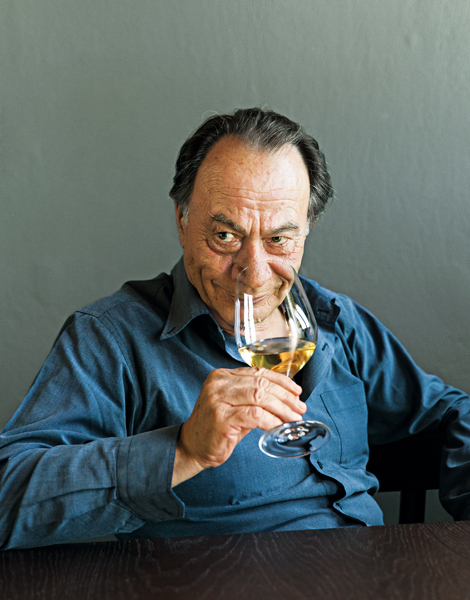
© Dimitris Vlaikos
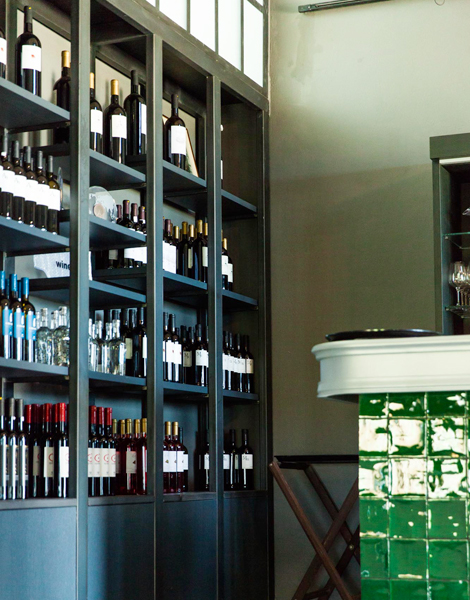
© Dimitris Vlaikos
DOMAINE SIGALAS
DRIVEN BY EXPERIMENTATION
Thanks to the efforts of the mathematician Paris Sigalas, Domaine Sigalas now enjoys a prominent position internationally. Sigalas considered it his personal mission to salvage the Santorini vineyard and make it into a world heritage monument and he seems to have pulled it off. His vineyard stretches over 30 hectares, 10 of which are cultivated in a linear way, while the rest use the island’s traditional basket method.
Aside from the Assyrtiko – which he considers as the prime Greek grape – and other white varieties such as Aidani, Athiri, Gaidouria and Platana, he has also invested in Mavrotragano, a red, with which the vineyard has experimented since 1997. A total of 10,000 bottles of 100 percent Mavrotragano are bottled annually, after spending 18 months in new French oak barrels. It is a rare wine with a unique character. Furthermore, the Nychteri is also worth sampling, produced by maturing the free-run juice from freshly picked, overripe Assyrtiko grapes in aged French oak barrels for up to 30 months. The vineyard’s Santorini label includes perhaps the most typical features of the local wine, while the Kavalieros encompasses the true meaning of what Santorini vineyards are about.
INFO
Domaine Sigalas • Baxes, Oia
• Tel. (+30) 22860.716.44 • Open every day from April to November. Out of season by appointment.
WHY GO: A vibrant vineyard that is at one with the horizon and its surroundings • Meticulously prepared Mediterranean cuisine at the winery’s restaurant.
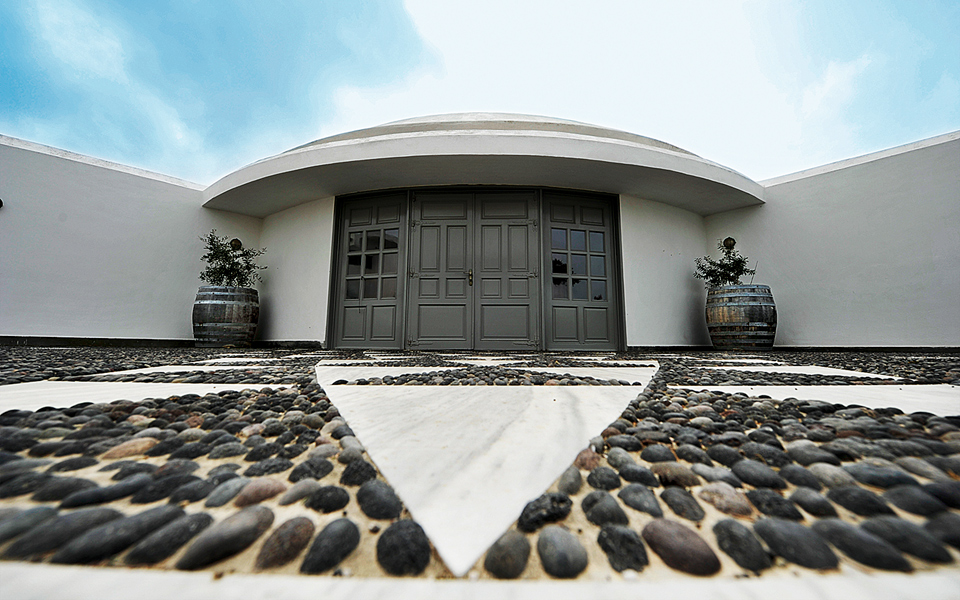
INFO
Boutari Megalochori • Tel. (+30) 22860.810.11
WHY GO: Wine tours and tastings with six different wines • Watch the exceptional video on the trail blazed by this Santorini winery in its spectacular Black Beach auditorium.
BOUTARI
GREECE’S FIRST WINERY
The name Boutari is synonymous with the Greek wine industry’s evolution. It was established in 1879, when the great- grandfather of the current owner took the unprecedented step of launching the first bottled Greek red wine. Today, the fourth generation of the family continues his work throughout Greece, holding firm to the motto that “every great wine should be produced in its natural place.” In the late 1980s, with the creation of a fresh, crisp and aromatic bottled label Santorini, Boutari transformed the wine landscape of the island, bringing it into an exciting new era. Since the launch of its innovative Kallisti wine, Boutari’s wines have maintained a consistent, terroir character. The most recent example is Oropedio, made with grapes from vineyards with low-yield gravelly soil, in the Mantinea region in Arcadia.
The company’s Santorini vineyard is planted with Aidani, Assyrtiko, Athiri and Mavrotragano. Its winery in Santorini is also impressive from an architectural viewpoint, especially in the way it blends in effortlessly with its natural surroundings.
Try the Kallisti and the Kallisti Reserve, which are produced using new methods that give the wine an exceptionally complex, unforgettable character.
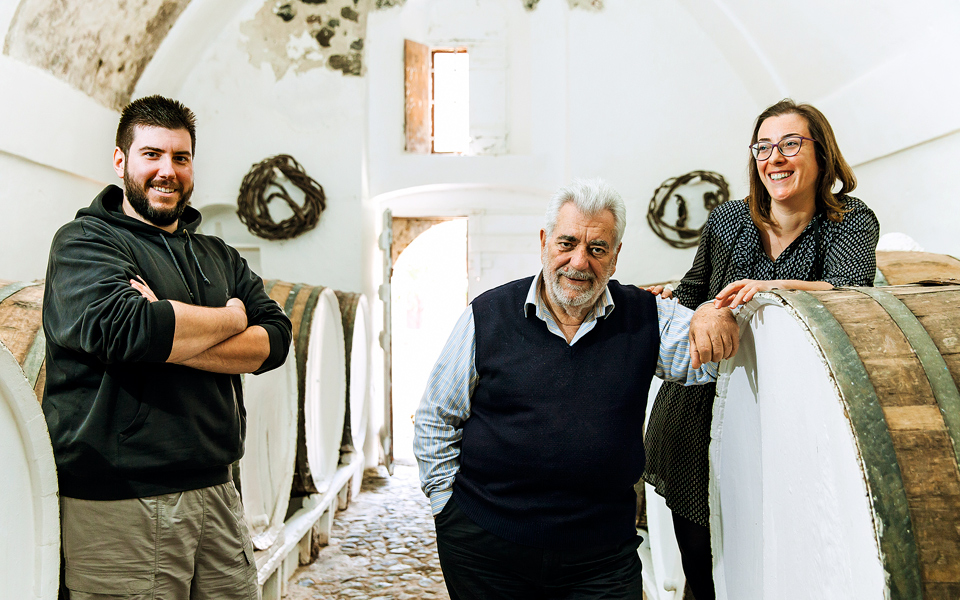
© Dimitris Vlaikos
CANAVA ROUSSOS
AGED TO PERFECTION
With its earliest contracts confirming its foundation in 1836, this is Santorini’s oldest winery and the epitome of a traditional canava, a cellar dug into the rock. Two siblings, Agape and Spyros, are the vineyard’s fifth generation of winemakers. Under the guidance of their father Yiannis Roussos, who still oversees the entire operation, they have been given a wealth of winemaking knowledge and tradition.
A tour of the winery is like embarking on a journey of discovery about what is necessary to ensure the smooth operation of a canava. Robust wicker baskets are used to carry the grapes, while the barrels stand on hollow bases that allow them to oscillate in the event of an earthquake. The windows enable the Meltemi northerly wind to pass through. The family’s philosophy is demonstrated by the fact that they do not bottle every year, preferring to wait until they believe the wine is absolutely ready. Across their privately owned 3 hectares, the family cultivates all the island’s varieties – Aidani, Athiri, Assyrtiko, Mandilaria and Mavrathyro – producing a total of nine labels. Be sure to try the Mavrathyro, which is made from red sun-dried grapes, as well as the Nychteri.
INFO
Canava Roussos • Episkopi Gonias
• Tel. (+30) 22860.313.49
WHY GO: For the family atmosphere in the refreshingly cool courtyard space • To try the same remarkable wine at various stages of maturation.
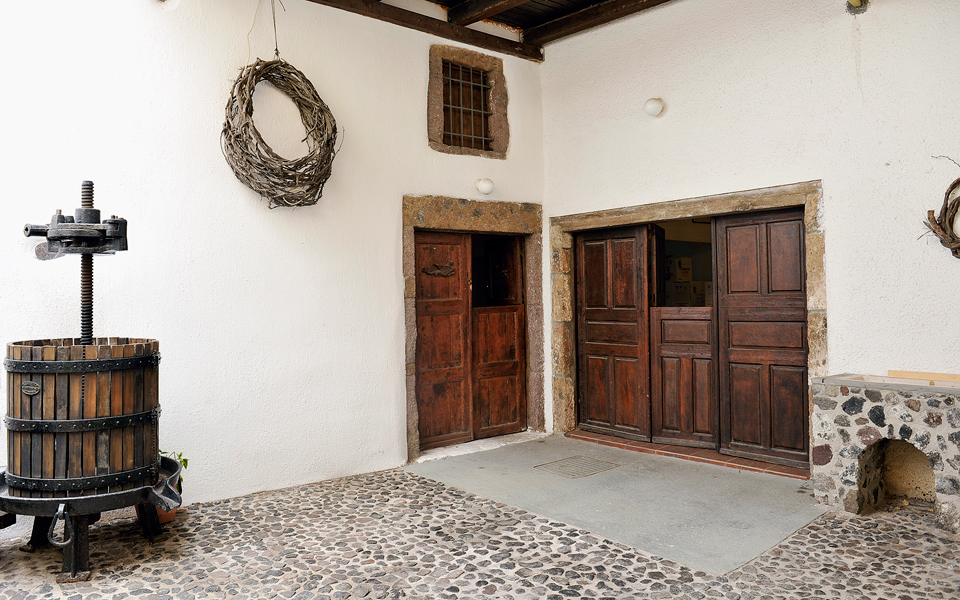
© Vangelis Zavos
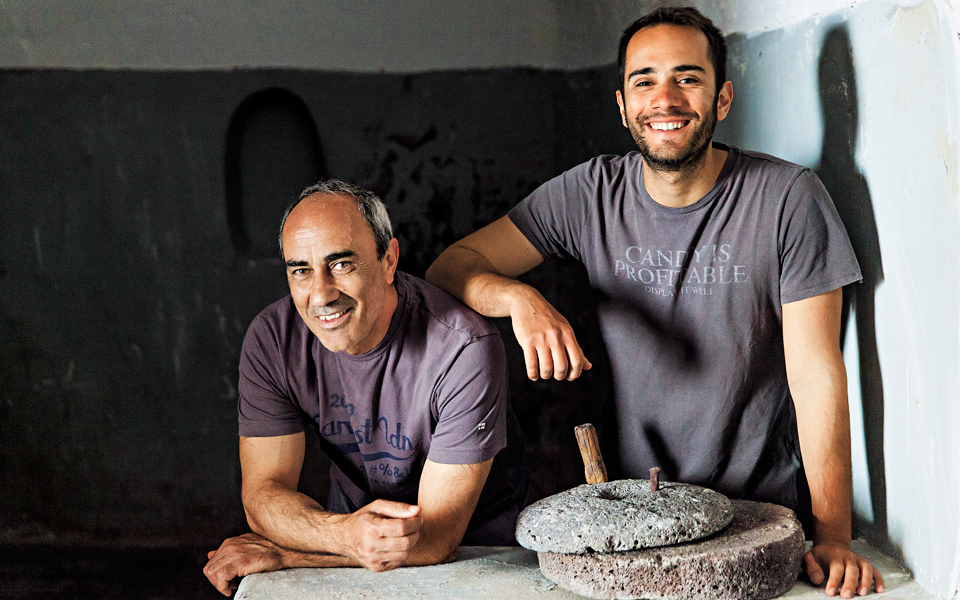
© Dimitris Vlaikos
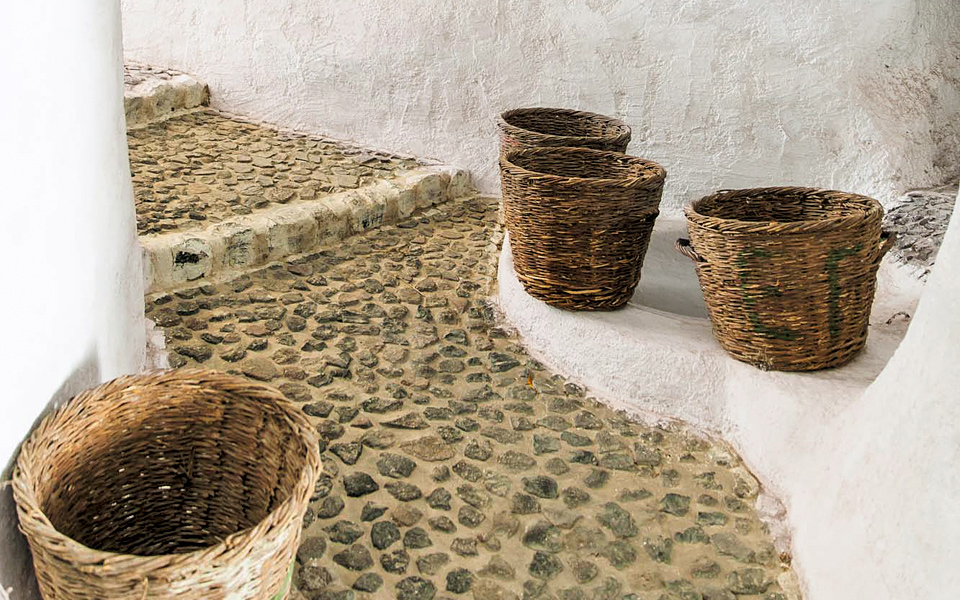
© Vangelis Zavos
INFO
Gavalas Wines • Megalochori
• Tel. (+30) 22860.825.52
WHY GO: Taste rare wine varieties in a traditional winery.
GAVALAS
Spotlight on Indigenous Varieties
Those lucky enough to be on the island in late August can take part in a great celebration at Gavalas Winery, the pressing of the grapes which are used to make Vinsanto. A traditional winery, Gavalas adheres, almost ceremoniously, to many of the older production methods. Winemaker Giorgos Gavalas – a fourth-generation vintner – along with his son Vangelis, produce nine versions of island’s native varieties, in collaboration with grape producers in Megalochori, Emporio and Akrotiri. The winery’s annual production totals 70,000 bottles, 60 percent of which are exported to the US, Japan, Belgium, France and the UK. While Assyrtiko takes the leading role in terms of cultivation and vinification, Giorgos and his winery have gained much respect and plaudits for the smaller, lesser known local varieties such as Voudomato and Katsano. The Voudomato rosé, for example, has an extremely fresh taste, a result of the production process whereby the pomace remains in the pressed grape juice for around six to seven hours. No more than 3,000 bottles of this wine are produced annually, so it is well worth sampling. The winery has also created a nursery to experiment with Voudomato and Gaidouria, as well as some other varieties that the winemakers are keeping secret as they hope to use them to make their next best label in 10 years’ time.
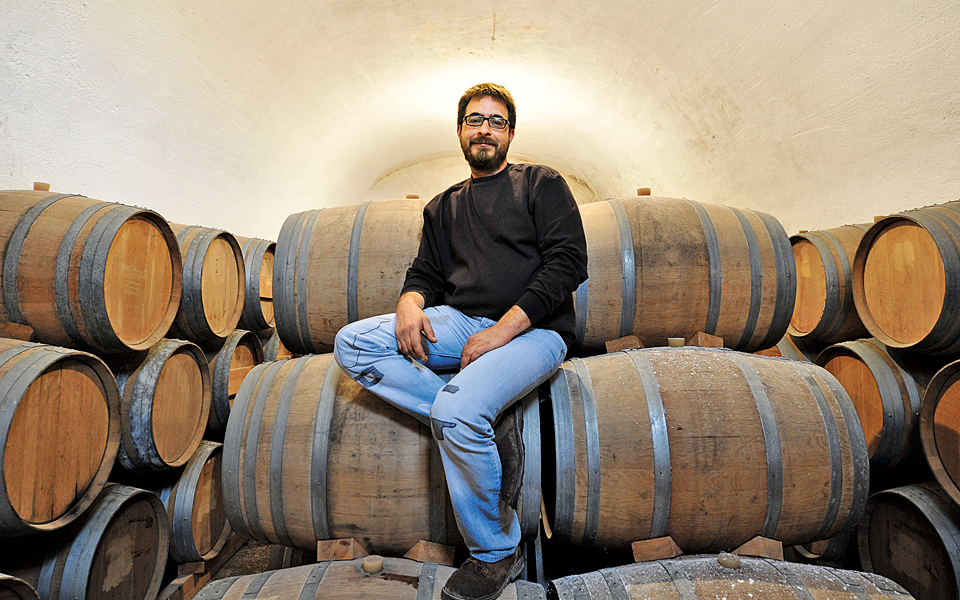
© Vangelis Zavos
ESTATE ARGYROS
Investing in Vines
Established in 1903, the vineyard is now in the care of the fourth generation, with Matthew Argyros at the helm of the continuing success story. The family have the largest single vineyard on Santorini, stretching over 40 hectares, with Aidani, Athiri, Assyrtiko and Mavrotragano vines, some of which are more than 150 years old, grown using the traditional methods. The largest section of the vineyard with the oldest Assyrtiko vines is located close to the winery in Episkopi.
Its wines have won many awards in Greece and abroad; Wine & Spirits ranked Estate Argyros among the top 100 in the world in 2005, 2006, 2013 and 2014. The estate also achieved the highest ever rating received by a Greek wine from leading wine critic Robert Parker, who gave its 20-year-old Vinsanto a score of 97/100. Visitors may enjoy the great aged Vinsanto for themselves, albeit in the four- and 12-year-old versions, at a winery tasting. The privately owned estate hopes to open a new winery for visitors soon.
INFO
Estate Argyros • Episkopi Gonias
• Tel. (+30) 22860.314.89
WHY GO: For a complete, integrated wine-tasting experience in a traditional environment • To buy a bottle of the star of the vineyard, the rare and exceptional 20-year-old Vinsanto.
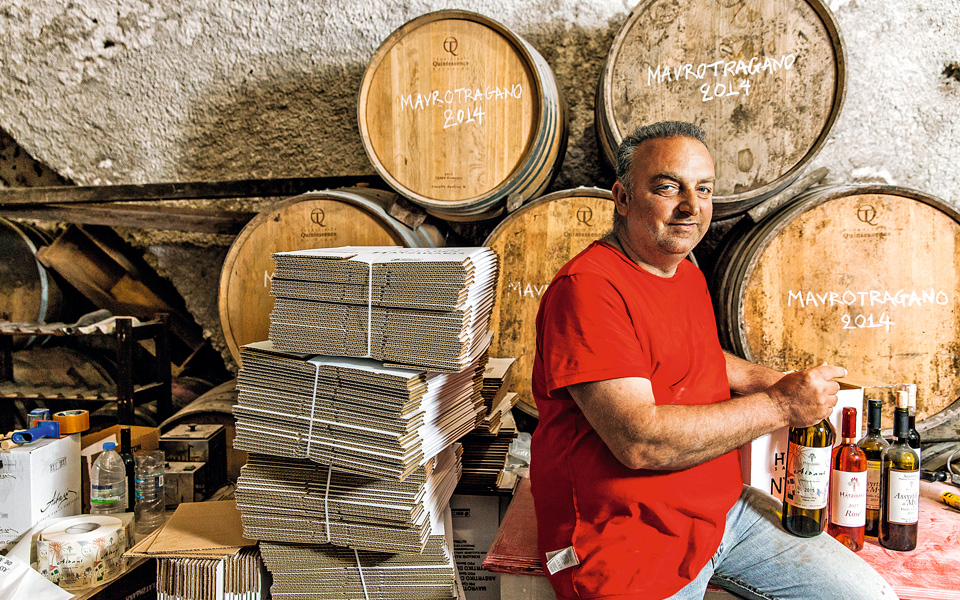
© Dimitris Vlaikos
INFO
Hatzidakis • Pyrgos Kallistis
• Tel. (+30) 22860.324.66
TIP: The new winery, slated for completion in June 2016, is well worth a visit.
HATZIDAKIS
A Humble Producer with Character
A man who keeps a low profile but is extremely active, and has a deep understanding and knowledge of wine, Haridimos Hatzidakis came to work in Santorini in 1990 as an oenologist. In the end, production won him over. A fan of working with smaller vines, Hatzidakis uses indigenous yeasts in the winemaking process to highlight the terroir. The grapes are organically grown over an area of 12 hectares which are planted with Aidani, Assyrtiko, Mandilaria, Mavrotragano and Voudomato – yielding around 120,000 bottles per year, half of which are exported to the US, Canada and the UK.
The new winery is a towering structure built into the rock, giving it a constant indoor temperature of 16C due to the insulation provided by the natural soil. In fact, the storage area follows the tradition of having a north-facing window for better ventilation.
It’s worth asking to try the Assyrtiko de Louros, a 100 percent Assyrtiko from a special vineyard that is rich in minerals from the volcanic rock. A very sophisticated wine, it is matured for two years in oak barrels and produced in a limited amount of just 1,000 bottles annually.
All the company’s wines bear the distinct character of the winemaker, so even if you are not a wine specialist, the second time you have a Hatzidakis, you’ll recognize it.

© Vangelis Zavos
AVANTIS ESTATE
Wine Without Borders
With a great family tradition in wine, Apostolos Mountrichas has managed to produce some excellent wines over his two decades in the business. And since winemaking is not tied to a particular region, he decided to try his hand at cultivating Assyrtiko in Santorini. Currently the manager of the 200-year-old canava in the basement of the 19th century Argyros Mansion, which has been restored and is open to the public, Mountrichas uses the traditional cellar to mature his wines in barrels.
With grapes from a 4-hectare vineyard in nearby Pyrgos, he produces three varieties, which are sent to the winery of his friend Giorgos Gavalas for vinification. His popular Dolphins Santorini, which consists of 100 percent Assyrtiko, is aged for eight months in large barrels called tuns. He also produces a rosé from Mandilaria called Grace. You can find Dolphins Santorini throughout Greece and in Japan, while the other two wines are currently only available in Santorini.
INFO
Avantis Estate • Mesaria
• Tel. (+30) 22860.302.42
WHY GO: To see an exceptionally preserved, 200-year-old canava.
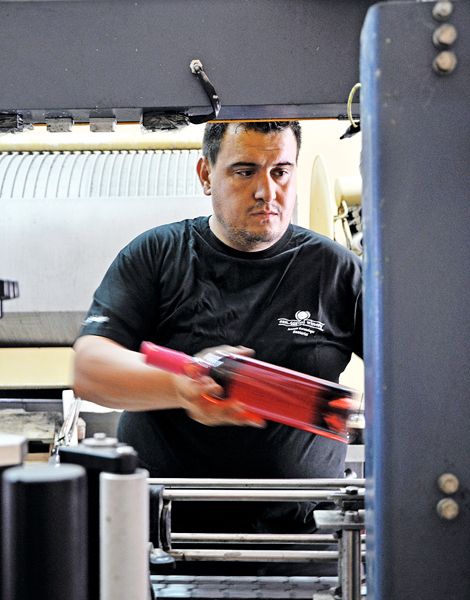
© Vangelis Zavos
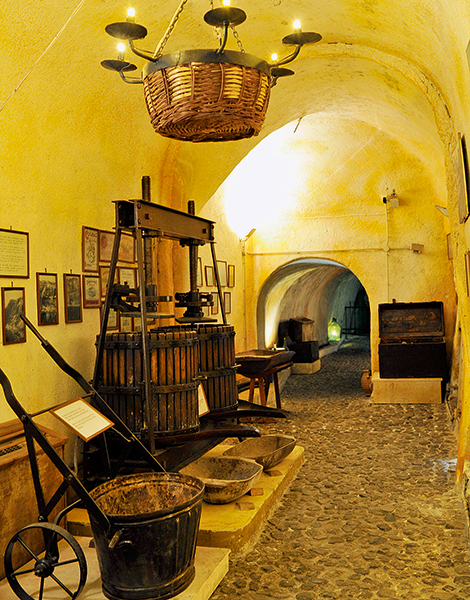
© Vangelis Zavos
INFO
Artemis Karamolegos • Exo Gonia
• Tel. (+30) 22860.333.95
WHY GO: For a complete wine tasting experience in beautiful surroundings.
Giorgos Koutsoyannopoulos • Vothonas
• Tel. (+30) 22860.313.22
WHY GO: For the priceless exhibits that can be enjoyed via audio tour in 14 languages.
ARTEMIS KARAMOLEGOS
A Winemaker’s Passion
A young man with a huge passion for wine, Artemis Karamolegos has put all of his energy into the creation of a series of remarkable wines. While he says he inherited the wine gene from his grandfather of the same name, he has taken his namesake’s ideas even further, planting new vines, making sure to maintain older ones as well as preserving the indigenous varieties. Today, his winery – which is now in its 12th year – cultivates Aidani, Assyrtiko, Mandilaria, Mavrotragano and Voudomato, in a state-of-the-art facility.
Located next to the winery, the Aroma Avlis restaurant serves excellent Mediterranean Greek cuisine. Wine tastings take place in the restaurant, which overlooks the valley and whose courtyard is filled with the wonderful aroma of herbs. The rosé, which is a blend of Assyrtiko and Mandilaria, is a must-try, as is the Vinsanto from sundried grapes, which is also aged for 60 months in a cask before bottling.
GIORGOS KOUTSOYANNOPOULOS
A Living Museum
Although it could be said that the decision by Giorgos Koutsoyannopoulos’ ancestors to establish a winery on the island was by chance – the winds are said to have pushed them and their ship towards Santorini by mistake – the family’s fortunes and what they have brought to the Greek wine landscape is definitely no accident.
Dedicated to producing fine wine for decades, the family has managed to create a unique, underground wine museum in a cave. Located 8 meters below the surface, the labyrinth measures 300 meters in total and contains authentic and rare artifacts dating from 1660 to more recent times. Not to be missed is the Kamaritis, a wine of six indigenous varieties, which is aged for 10 years in oak barrels before bottling. Made according to a secret recipe handed down by Giorgos’ great-grandfather, only 4,500 bottles are produced each year. They are available only at the winery.
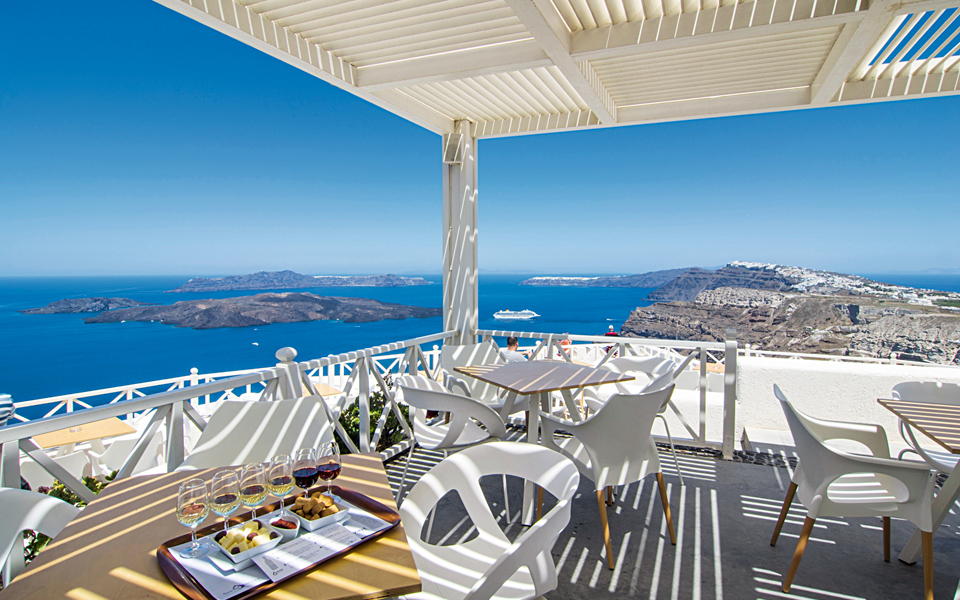
© Dimitris Vlaikos
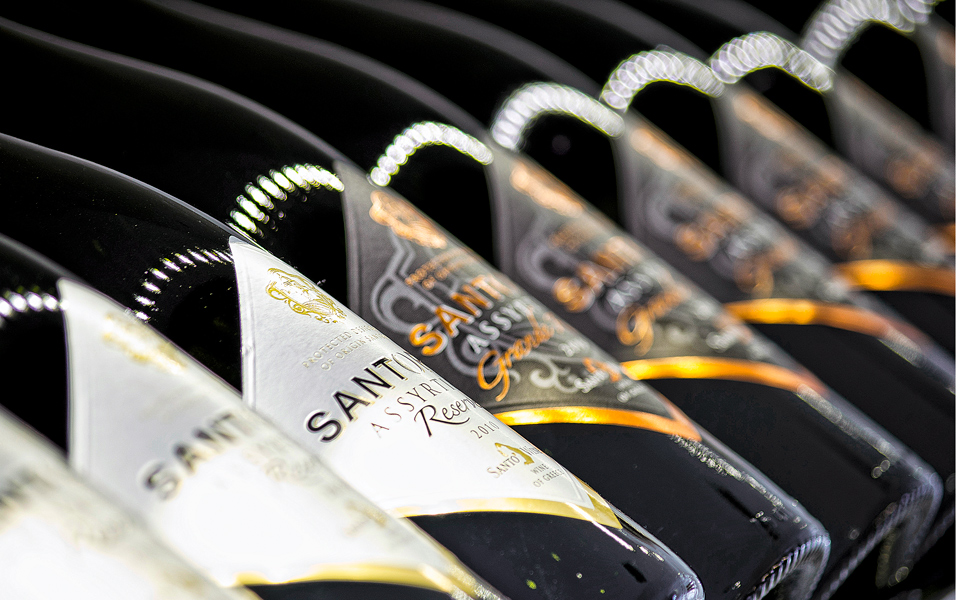
© Dimitris Vlaikos
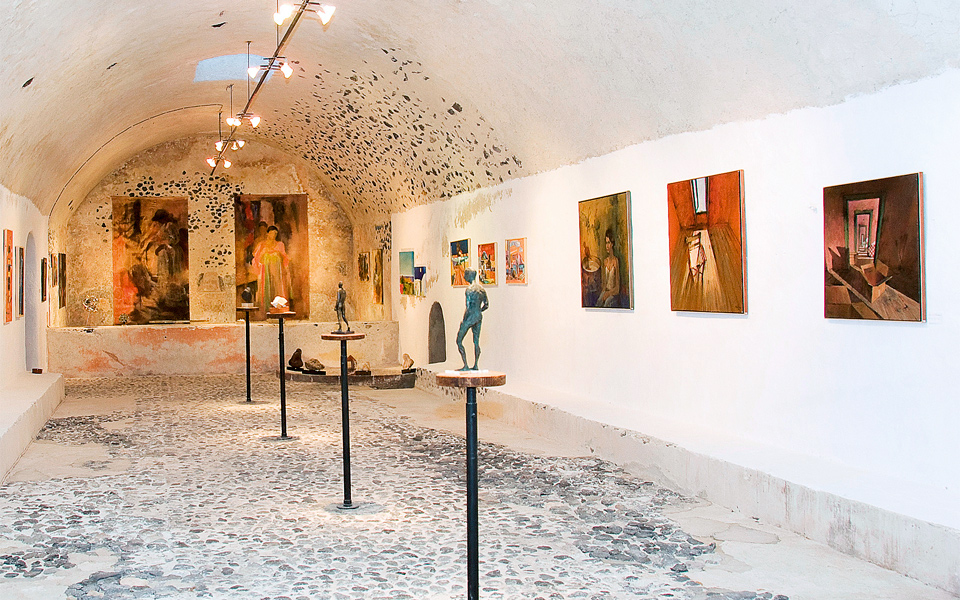
© Vangelis Zavos
SANTO WINES
Much More than a Winery
This thriving cooperative boasts more than 1,000 members, who proudly cultivate and harvest the Assyrtiko grape as well as other lesser-known varieties. Apart from being a modern winery, Santo Wines can look back at a history of almost 70 years of actively supporting the island’s economy. Not only does it produce, process and standardize wine, but it also does the same for some other native, emblematic products of the island, distributing them to markets around the world. Established in 1991, the cooperative’s winery is located in one of Santorini’s most beautiful spots, while its recently renovated tomato processing plant is the only one on the island. The surrounding area is extremely well maintained, making it an ideal spot for all kinds of special events, even weddings.
Over 400,000 visitors have already enjoyed tasting the cooperative’s selection of between 6, 12 or 18 different wines accompanied by delicious local snacks on the winery’s Sunset Terrace. If your main interest is vino, there are wine tours on offer, plus an interesting documentary about the island’s great history and winemaking tradition. The gift shop sells all the cooperative’s products, from their renowned canned Santorini tomatoes to sauces, purees and pastes, to sun-dried tomatoes or cherry tomatoes with olive oil, capers and summer savory, ready to be eaten as a dip with a salad or bread. Other items on sale include yellow split-pea lentils (the main ingredient of the island’s famed fava), capers and other delightful products from small producers throughout the country, such as Cycladic honey, spoon sweets, loukoumia (the local version of Turkish Delight) and nuts.
INFO: Pyrgos • Tel. (+30) 22860.280.58 • www.santowines.gr
| WHY GO: To admire the breathtaking view from the amazing terrace while sipping on fine wine
STOPS
ART SPACE
In a building that dates back to 1861, Art Space today is a museum and modern winery created by Antonis Argyros. Apart from artifacts from the traditional winery, the museum showcases the equipment used to produce tomato paste up to the 1920s. The gallery exhibits contemporary works by young Greek and foreign artists, in a quaint space in the basement. The new winery is housed in an adjacent canava. Current annual production is limited to 7,000-10,000 bottles, produced from 1.3 hectares of Assyrtiko and Mavrotragano.
Exo Gonia • Tel. (+30) 22860.327.74
EXPERIENCE ABELIS
Located in the medieval village of Vothonas, this late-17th century winery reopened this year. Belis’ Canava, as it was known, consists of six smaller canavas that have remained intact. Its restoration was accomplished using natural materials and old techniques in order to emphasize the original character of the space. Visitors can see the area where the grape must is stored and the grapes are pressed, and can enjoy an audio-visual tour of traditional winemaking. Tastings are available at a venue that is also used for events to promote the island’s culture.
Vothonas •

